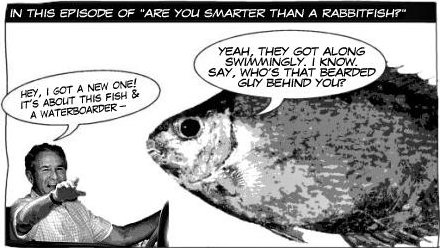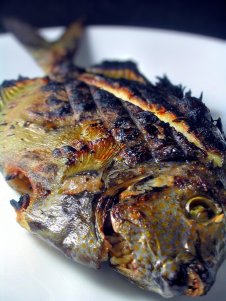
Are you up for some idle speculation? On the table is the matter of how a certain fish got its name. Ready?
Analogy. Once upon a distant time, an Anglo-Saxon fisherman reeled in a strange specimen from the shallows. “Well look wat we ’ave ’ere,” he said to his companion. “Ne’er seen the likes of dis fish afore, ’ave we? Just lookit ’em big peepers an’ funny snout — don’t dem remind you dose hoppers dat breed crazy like the devil be ’ere on the morrow? A rabbit — da’s right! Looks like one a dem hornee bunnies. Right then, da’s wat dis bloody gaspin’ salt-monster is: a rabbitfish!”
Contrariness. I have no proof that the word “spinefoot” — which is another name for the rabbitfish — was coined by an American, but I venture that it was. Why? Just because, that’s why. Never mind that a spinefoot doesn’t have a foot; when it comes to anything foreign, trust the Joes to throw a monkey wrench — oops, a spanner — in the works. Whether out of spite or arrogance, they just have to have the final word. “This here’s a spinefoot, and that’s that: either you’re with us, or against us.” Damn Yanks. Almost makes you wish they’d step on the fish’s painfully venomous spines. Almost.
Perversity. Who’s got the wicked humor to call this fish “happy moments?” Surely not the stuffy Brits or their seppo cousins. But those Australians, they’re something else, certainly not like the rest of us, if only because they live in a place where even water drains in the wrong direction. So we caution, “Steer clear of that rabbitfish; it stings like a mother!” whereas they go, “Happy moments up ahead, mate; you in the mood for a thrill?” As in, “Whatever mood you were in before, you would definitely consider yourself happy, moments before you stepped on that fish.” I know — I said “wicked,” didn’t I? A case could be made for them Aussies being contrarians, except that they actually laugh at themselves. How’s that for cool?
Best of Three. In prehistoric Visayas, a meeting among tribal chieftains:
CHAIRMAN: And last on today’s agenda is a proposal to formalize the name of a certain food fish with the following characteristics: mottled, spiny, herbivorous, queer snout, yadayadayada… Suggestions, anyone?
CHIEF 1: How about tabaghak?
CHAIRMAN: Sounds like a cuss word.
CHIEF 1: Well, isn’t that what folks do when stung by that thing — curse?
CHIEF 2: I say we call it kitong.
CHAIRMAN: Hmmm… I like it — that initial hard “k” sounds forceful.
CHIEF 3: Scratch that, homies. I have just the word: buchikik!
CHIEF 2: That’s not a word.
CHIEF 3: And kitong is? Hrmpf.
CHAIRMAN: Go sing a silly song, Brod Yoyoy.
And that, folks, is what happens when you get carried away writing an introduction to a post about last night’s dinner. I should get a life; watch a movie or something…

But back to dinner: Call the fish what you like and it would still have tasted as good. Rubbed with kalamansi juice, coated with a bit of oil, generously salted, stuffed with Visayan mirepoix (chopped garlic, onion, spring onion, and tomato), and grilled over smoldering charcoal until its skin was nicely charred — what was there not to like?
There is a word in the vernacular that describes the essence of fish such as this: pughad, meaning “firm of flesh,” as opposed to basâ (waterlogged). The white meat comes right off the bones and tastes clean and light (though there’s a catch, but more on that later). Served with a dipping sauce of native vinegar mixed with a bit of soy sauce, kalamansi juice, and lots of red chilies, I can eat a whole fish by myself, no sweat.
Kitong is one of 27 described species that belong to the genus Siganus. Now here’s a piece of trivia I bet only a few know: rabbitfish are also considered ornamental — the colorful ones, at least. Alas, Siganus fuscescens is deemed too drab by hobbyists. That’s our kitong, by the way. So if you ever happen to have a meal with an aquarist where kitong is served, feel free to tell said person (and in your most indignant tone of voice), “Look who deigns to eat stinking drab now!” then grab that first-class fish for yourself. Suggest ko lang…
Speaking of which, some people have a real problem with kitong being considered first-class. The reason? It stinks. And does it. The stench specifically emanates from the abdominal cavity, which often results in the assumption that whatever it is this creature eats must be truly vile. Wrong, as it turns out. The kitong is a finicky eater, even by Siganid standards; algae make up most of its diet, and even then it prefers fresh, newly grown algae. Further research yielded something about the rabbitfish’s “inefficient stomach” (it’s a herbivore), so I can only surmise that: a) its intestines seriously need re-wiring, b) its algae diet is equivalent to us humans exclusively eating kamote (sweet potato), c) the stench is a desperate defense mechanism to deter us from consuming it (in which case it fails miserably, and what’s the use, you ask, since dead is dead, no matter how you cut it?), or d) all of the above.
Worse than the smell is the taste: if you’ve ever wondered how fish marinated in shit tastes, try improperly prepared rabbitfish. I am so not kidding. Fortunately, I can tell you that rabbitfish only stinks and tastes of crap inasmuch as butete is deadly: there is a technique involved. Better yet, you don’t need an advanced degree to do it. All it entails is careful removal of the intestines. When you slice the abdomen, take care not to drive the knife any deeper than you need to in order to access the guts — that way, you avoid perforating the digestive tract, which is where the stinky bile awaits to ruin your meal. Use kitchen shears, if need be. You can have the fish vendor do it for you, but you have to be explicit about how you want the “operation” carried out (you’ll be surprised how many get it wrong, or are just too careless). Rinse that fish thoroughly, concentrating on the abdominal walls, and finish off with a vigorous kalamansi rub for good measure. Goodbye, stinkeroo. So long, fecal flavor.
And that, folks, makes a wonderful dinner. I apologize for the scatology; it couldn’t be helped. Just wait until I work up the courage to try pinya-pinya…
Source photos: George Bush, US Department of State; Rabbitfish, World Sports Fishing Federation
This post has no comments.
Post a Comment